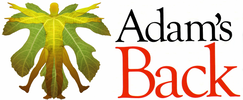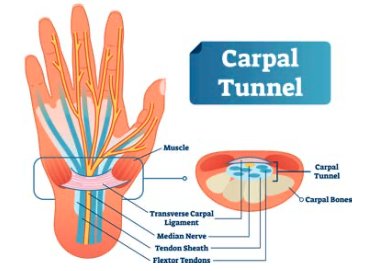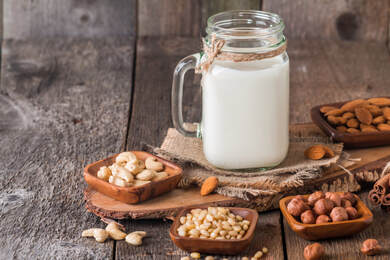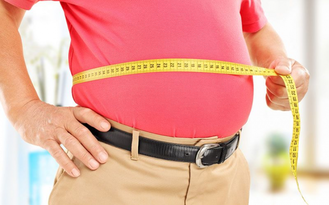Do you experience numbness or tingling in your hand, particularly of the thumb, index and middle fingers?Do you drop items, especially when you try to pinch? Does your palm hurt to touch? Do you find yourself shaking your hand to gain relief from these symptoms, most notably during the night? You might have carpal tunnel syndrome (CTS).
The carpal tunnel is a narrow passage formed by your carpal, or wrist bones. These bones form the floor of the tunnel while a thick fibrous tissue band creates the roof. The median nerve and muscle tendons that help flex your fingers pass through this tunnel, where they are protected. However, because this space is small, if the tendons become swollen or thickened, the nerve can become compressed and cause CTS. CTS usually develops slowly and remains persistent. When the tendons thicken from overuse they require additional space, leaving less room for the nerve. Swelling has the same effect. Less commonly, a local fracture or infection, a tumour, or an underlying disease like arthritis or diabetes, can also reduce space and cause this condition. Symptoms The symptoms are due to reduced median nerve function. This nerve provides feeling, and enables muscles to contract. So, when compromised, these functions are affected. The median nerve supplies sensation to more than half of the palm, the thumb, index and middle fingers; so you may experience tingling, numbness and pain in these areas. Sometimes it can be a sensation like a mild electric shock. The pain can extend up the forearm. The motor part of the median nerve is responsible for movement of the thumb so, when harmed, weakness can occur. This can contribute to poor pincer grip strength – potentially making it difficult to hold a cup, twist jar lids, write, even do up buttons and put in earrings. When severe, the muscular mound at the base of the thumb can waste away. How does CTS happen ? While there are biological factors that increase risk, like being female and pregnancy, there are other factors that can be addressed. Occupational stressors play a role. Repetitive bending of the wrist and exposure to hand-transmitted vibration elevates risk, making assembly line workers, cashiers, drillers, meat packers, computer workers, and sewers more vulnerable. So a safe, ergonomic work space and reduced awkward wrist and hand postures are helpful. If CTS does occur, treatment options are available. The use of a splint to maintain a neutral wrist position may help. An exercise program that targets arm and shoulder circulation, flexibility, and power can restore reduced grip strength. Carpal tunnel syndrome can be disabling, so prevention is key. If you think you may be at risk of developing carpal tunnel syndrome, speak to your Adam's Back chiropractor about the best preventative measures for you.
1 Comment
17/9/2020 0 Comments Saying Goodbye To Gardening PainsWhether you are a weekend warrior or a dedicated horticulturist, gardening is a hobby worth more than its weight in tomatoes.Spending time with your hands in the dirt can boost your quality of life. Pottering amongst your plants can calm stress, encourage a positive mood, reduce the symptoms of anxiety and depression, and enhance brain function.
But, as with many activities, poor posture and repetitive physical strain can trigger discomfort. In the veggie plot, this is nicknamed gardening pains. By understanding how you can hurt your back, you can implement steps to ease pain, and help yourself and your garden to thrive. When we overstretch or bend incorrectly, like a twig with too much pressure, we can break. Hours spent bent over, lifting pots and plants with poor technique, and reaching to the rear of plant beds stresses the spinal joints and back muscles. This can lead to fatigue, injury and pain. Correct lifting methods, ergonomic tools and regular rest breaks can prevent harm. When you lift, bring your feet close to the item and keep them hip width apart with one foot slightly in front of the other. Squat, maintain an upright spine and look straight ahead. Hold the load near your body. Lift by slowly pushing up with your legs; don’t use your back. Slowly change direction using small steps. Reverse the lifting process to put the load down. Above all – make sure the load is not too heavy or bulky. Invest in quality ergonomic tools. Did you know there are long handled weed removers, ergonomic light-weight spades, padded kneeling seats, and deluxe gardening scooters? Use them. A trolley will assist in the easy movement of materials, plants and tools. A raised no-till garden will lower effort and the need to bend. Remember to schedule rest and recovery. Garden for a set period of time and then gently walk and stretch. Gardening is a hobby well worth pursuing, with physical, psychological and potentially nutritional benefits. If back pain does strike, your chiropractor can provide advice and appropriate care. 17/9/2020 0 Comments Nut MilksMore and more people are choosing plant-based alternatives to traditional meat and dairy products. Whether you’re considering switching from dairy for animal rights, health, environmental reasons, or if you just prefer the taste, the options are increasing all the time.Plant milks have been made and used for hundreds of years, but until recently, the only common dairy alternative available was soymilk – although a good option it’s not to everyone’s taste. Choices now include rice, oat, hemp, or coconut milk, as well as a variety of nut milks. Nut milks are naturally gluten, lactose, and soy-free.
If you are looking for environmentally- friendly alternatives, almond milk comes under criticism for consuming a large amount of water during farming and production. It’s still less than dairy milk, but certainly not ideal. Greenhouse gas emissions and land use for the production of plant-based milks are lower than for dairy milk. The nutrition content depends upon the plant source and the processing. Typically, nut based milks are highly diluted; therefore don’t contain high quantities of nutrients. For this reason, many are fortified with vitamins and minerals. They can also have sugar and other additives, so it’s worth checking the packaging for a full run-down of the ingredients. Nut milks have less protein and calcium than cows’ milk and therefore they are not recommended as a complete milk replacement for children, teens or pregnant women. On the other hand, people who need to limit their calories or saturated fat intake may benefit from some plant-based milks. Common Nut Milks
With a huge range of nut milks and other dairy alternatives, have fun finding your personal favourite or making your own! Photo from Pinterest 17/9/2020 0 Comments Is A Big Belly Hurting Your Back?As waist circumference creeps up, our health can sufferThe risk of issues such as type 2 diabetes, high cholesterol, elevated blood pressure and cardiovascular disease are increased. But have you ever wondered if your paunch might also be hurting your back?
The spine is made from many vertebrae that sit one on top of another, joined at the back by facet joints. These joints are a little like snap-together modular flooring. Each one fits together beautifully, and is aligned in a way to support your spine and allow healthy movement. They, in essence, provide strength and structure while preventing your head or torso from spinning all the way around! Because of their design, we can walk upright, bend, twist and move safely. However, a large waist girth alters the physics. It’s like carrying a heavy sack of potatoes on your front. The additional continuous pressure tips the pelvis forward and drags the attached vertebra with it. It increases the forward curve in the lower back, and one vertebra then pulls on the next. The postural distortions can often be seen by the eye. These changes alter the pressure applied through the facet joints, and can trigger muscle tension – increasing the risk of pain, injury and degeneration. People usually gain weight from a poor diet, lack of exercise, poor sleep and stress. When a person consumes more calories than their body burns, the excess energy is stored as fat, and some of this is deposited in the abdominal area. A large hanging belly, also known as the panniculus, can occur following pregnancy or significant weight fluctuations. It’s often called an apron belly, and can hang from the top of the pubic area to the knees. The apron is made solely of excess skin and fatty tissue deposits. When combined with the weakened abdominal muscles that are common post-pregnancy, this apron can be pronounced. For many reasons, it’s important to address a big belly. Strengthening the abdominal muscles may provide back pain relief, but it’s also important to protect yourself from future illness and discomfort by reducing your belly size. Your chiropractor can assess your posture, discuss treatment options for back pain and advise on ways to lower stress and achieve a healthy weight. Photo from Pinterest 17/9/2020 0 Comments Your Body's Balancing ActHave you given much thought to your balance? Or do you, like many others, take this ability for granted?That’s understandable – it’s often only when we experience a problem that we give it more thought. Yet, balance is more than simply remaining upright. There are complex processes that allow us to move, turn our heads without our vision blurring, quickly readjust our muscles to support stability and stay vertical.
We all stumble or experience clumsiness on occasion. We may bump into the doorframe or sway when we get up too quickly. But when balance issues become chronic, the symptoms are usually caused by an underlying problem and can be troublesome, incapacitating, and dangerous. Symptoms may include a sensation of spinning or lightheadedness, blurred vision, hearing changes, stumbling, falls, decreased spatial awareness, poor depth perception, and nausea. It may also contribute to fatigue, anxiousness, and confusion. How do we balance? It’s an important question. Just as a car has many components that allow it to safely take a corner at speed, we have many interworking parts that allow us to remain stable. We must sense where we are in space, make constant small adjustments that bring us back to centre, and integrate these functions seamlessly. This begins within the ears. The inner ear has small organs that contain fluid and hair. As you move your head, the fluid shifts, the hair bends, and this information is sent, via nerves, to the brain. Each organ provides feedback on movement in a certain direction: tilting upward or downward, leaning to the left or right, turning sideways, and accelerating. Inner ear infections or ear crystals upset this ability, which is why they can cause dizziness and imbalance. The eyes provide visual input – they send impulses to the brain that provide visual cues identifying your position relative to other objects. To understand this, stand on one leg and bend your other knee. How balanced do you feel? Now, try it with your eyes closed. The difference is marked. The skin, muscles and joints, particularly of the spine, are also involved. As they move, they continuously transmit what is called proprioceptive information regarding their position, relevant to the body parts they connect to. For example, increased pressure is felt in our heels when we lean back. These cues help our brain determine where our body is in space. The remarkable combination of input enables us to sense when we are moving, in which direction, and at what speed. We then respond to that information, often subconsciously. Nerves fire, muscles move us in appropriate ways, and we are, usually, able to right ourselves. The balance system also provides feedback on the success of these manoeuvres, allowing further adjustment. Maintaining optimal balance is important – these activities may help.
If you are experiencing balance problems, ask your Adam's Back chiropractor for advice. |
AuthorAdam's Back is a team of dedicated complimentary health professionals. Our aim is to support you in finding drug-free solutions for better health. Archives
July 2024
Categories |
Search by typing & pressing enter






 RSS Feed
RSS Feed